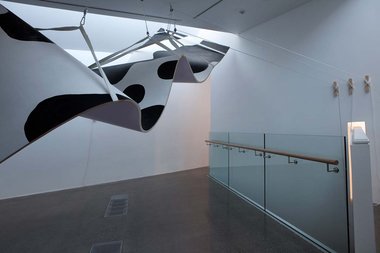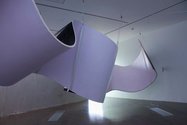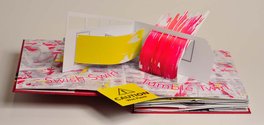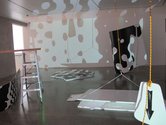John Hurrell – 4 March, 2015
As a piece of suspended sculpture, Millar's Gallery Four project up on the top floor alludes to an unfurling 'brushstroke', being a buckled strip made of thick laminated plywood that is painted. Like any strip this hefty band has two sides: one covered with a black and white pattern of dots and knobby protrusions that seem to reference grainy photocopying or printing and enlarging of image; the other coated with a plain, very pale pink - as if an abstracted erotic body.
Auckland
Judy Millar
The Model World
13 February - 5 April 2015
Gow Langsford
Proof of Heaven
4 March - 28 March 2015
Swell publication
Devised by Trish Gribben, Phillip Fickling and Judy Millar
Hardcover, 12 pp
Te Uru 2014
Auckland currently has a number of new Judy Millar projects to be pondered over and enjoyed in Te Uru and Gow Langsford, as well as Swell - a ‘pop up’ book ostensibly for children but really for art loving adults.
Swell features the writing abilities of Trish Gribben and design skills of paper engineer Phillip Fickling, being a hardcover book with six collapsable paper sculptures that become erect when the double pages are opened up and flattened out. It is a very clever way of interesting people in Millar’s installation and painting practices, with its vibrant colour, surprising movements and witty references to Millar’s gallery projects; an inspired idea that with the luxury of hindsight might seem obvious, but which is nevertheless absolutely refreshing.
Published by Te Uru, the book’s ideas are extended by Millar through two installations in Titirangi. In Te Uru’s Gallery Three on the middle floor, five large sculptures covered with black and white patterns are painted on and bathed in light from a projector in the corner. They investigate ways of getting a sculpture to stay in position in space, looking at methods of support.
Two of these elaborate on designs and structural methods from the book by offering visitor participation. You can temporarily transform these forms, through pulling hard on a rope to raise a flap bearing wobbly bits on hinges, or turning a wheel that is on the floor to make a flat strip arch upwards like a serpent. It takes a certain amount of muscle to do this - not being possible for a child - and it might even get your arms aching if (like me) you never work out and are not used to it.
Millar’s Gallery Three installation also references her Gallery Four project up on the top floor. As a piece of suspended sculpture, it alludes to an unfurling, codified ‘brushstroke’, being physically a buckled strip made of thick laminated plywood that is painted. Like any strip this hefty band has two sides: one covered with a black and white pattern of dots and knobby protrusions that seem to allude to grainy photocopying or printing and enlarging of image; the other coated with a plain, very pale pink - as if an abstracted erotic and vulnerable body. The linear form might also refer to cosmological theories of the universe (or a universe) - its shape.
This convoluted form tightly interacts with the architecture of the room. It just squeezes in, being tilted and held in position by eleven slings and pulleys with nylon lines that extend downwards to be wound around wooden handles bolted to the walls. You can walk around and under it, exploring different undulating vistas and unexpected angles. As a sculpture that convincingly locks into the Te Uru space it is deeply satisfying. I think it is the best Judy Millar installation (or architectural intervention) I’ve seen so far.
The Model World (top floor) has a calming, contemplative quality that is quietly haunting. However in contrast, back in town in Gow Langsford, the six works on paper and eight canvases of Proof of Heaven - featuring the ‘subtractive’ paint removing process Millar is now famous for - have an exceptionally wild freneticism. They exude a high energy that sustains invention within the types of hyperactivity. Her looping sweeping swirls, clusters of pitted pockmarks from stabbing bristles, and convulsive finger-twitching wipes here crash and jostle to make a grinding cacophony of colliding textures that sucks you into its vortex.
There is a deeply Romantic baroque exuberance to these manic images, and the background colours peeking through the removed paint have a rainbowlike hippie sweetness that reminds me of some sixties Haight Ashbury or Peter Max posters. This backdrop adds to the ferocity of the marks: an unnervingly pretty contrast.
John Hurrell












 Two Rooms presents a program of residencies and projects
Two Rooms presents a program of residencies and projects Advertising in this column
Advertising in this column



This Discussion has 0 comments.
Comment
Participate
Register to Participate.
Sign in
Sign in to an existing account.